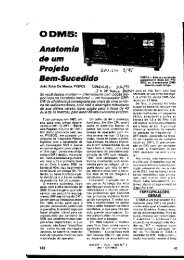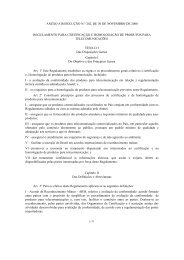A Software Defined Radio for the Masses, Part 3
A Software Defined Radio for the Masses, Part 3
A Software Defined Radio for the Masses, Part 3
You also want an ePaper? Increase the reach of your titles
YUMPU automatically turns print PDFs into web optimized ePapers that Google loves.
Signal Processing Library 4 to be located<br />
in <strong>the</strong> working directory. These<br />
files are included with <strong>the</strong> demo software.<br />
The <strong>Software</strong> Architecture<br />
Fig 1 provides a block diagram of<br />
<strong>the</strong> DSP software architecture. The<br />
architecture works equally well <strong>for</strong><br />
both transmit and receive with only a<br />
few lines of code changing between <strong>the</strong><br />
two. While <strong>the</strong> block diagram illustrates<br />
functional modules <strong>for</strong> Amplitude<br />
and Phase Correction and <strong>the</strong><br />
LMS Noise and Notch Filter, discussion<br />
of <strong>the</strong>se features is beyond <strong>the</strong><br />
scope of this article.<br />
Amplitude and phase correction<br />
permits imperfections in phase and<br />
amplitude imbalance created in <strong>the</strong><br />
analog circuitry to be corrected in <strong>the</strong><br />
frequency domain. LMS noise and<br />
notch filters 5 are an adaptive <strong>for</strong>m of<br />
finite impulse response (FIR) filtering<br />
that accomplishes noise reduction in<br />
<strong>the</strong> time domain. There are o<strong>the</strong>r techniques<br />
<strong>for</strong> noise reduction that can be<br />
accomplished in <strong>the</strong> frequency domain<br />
such as spectral subtraction, 6 correlation<br />
7 and FFT averaging 8<br />
Parse <strong>the</strong> Input Buffers to<br />
Get I and Q Signal Vectors<br />
Fig 2 provides <strong>the</strong> variable and constant<br />
declarations <strong>for</strong> <strong>the</strong> demonstration<br />
code. The structure of <strong>the</strong><br />
inBuffer() <strong>for</strong>mat is illustrated in<br />
Fig 3. The left and right signal inputs<br />
must be parsed into I and Q signal<br />
channels be<strong>for</strong>e <strong>the</strong>y are presented to<br />
<strong>the</strong> FFT input. The 16-bit integer leftand<br />
right-channel samples are interleaved,<br />
<strong>the</strong>re<strong>for</strong>e <strong>the</strong> code shown in<br />
Fig 3 must be used to split <strong>the</strong> signals.<br />
The arrays RealIn() and RealOut() are<br />
used to store <strong>the</strong> I signal vectors and<br />
<strong>the</strong> arrays ImagIn() and ImagOut()<br />
are used to store <strong>the</strong> Q signal vectors.<br />
This corresponds to <strong>the</strong> nomenclature<br />
used in <strong>the</strong> complex FFT algorithm.<br />
It is not critical which of <strong>the</strong> I and Q<br />
channels goes to which input because<br />
one can simply reverse <strong>the</strong> code in<br />
Fig 3 if <strong>the</strong> sidebands are inverted.<br />
The FFT: Conversion to <strong>the</strong><br />
Frequency Domain<br />
<strong>Part</strong> 1 of this series discussed how<br />
<strong>the</strong> FFT is used to convert discretetime<br />
sampled signals from <strong>the</strong> time<br />
domain into <strong>the</strong> frequency domain (see<br />
Note 1). The FFT is quite complex to<br />
derive ma<strong>the</strong>matically and somewhat<br />
tedious to code. Fortunately, Intel has<br />
provided per<strong>for</strong>mance-optimized code<br />
in DLL <strong>for</strong>m that can be called from a<br />
single line of code <strong>for</strong> this and o<strong>the</strong>r<br />
important DSP functions (see Note 4).<br />
The FFT effectively consists of a<br />
series of very narrow band-pass filters,<br />
<strong>the</strong> outputs of which are bins, as illustrated<br />
in Fig 4. Each bin has a magnitude<br />
and phase value representative<br />
of <strong>the</strong> sampled input signal’s content<br />
at <strong>the</strong> respective bin’s center frequency.<br />
Overlap of adjacent bins resembles<br />
<strong>the</strong> output of a comb filter as<br />
discussed in <strong>Part</strong> 1.<br />
The PC SDR uses a 4096-bin FFT.<br />
With a sampling rate of 44,100 Hz, <strong>the</strong><br />
bandwidth of each bin is 10.7666 Hz<br />
(44,100/4096), and <strong>the</strong> center frequency<br />
of each bin is <strong>the</strong> bin number<br />
times <strong>the</strong> bandwidth. Notice in Fig 4<br />
that with respect to <strong>the</strong> center fre-<br />
Erase RealIn, ImagIn<br />
For S = 0 To CAPTURESIZE - 1 Step 2 ‘Copy I to RealIn and Q to ImagIn<br />
RealIn(S \ 2) = inBuffer(S + 1) ‘Zero stuffing second half of<br />
ImagIn(S \ 2) = inBuffer(S) ‘RealIn and ImagIn<br />
Next S<br />
Figure 3 – Parsing Input Buffers Into I and Q Signal Vectors<br />
Fig 4—FFT output bins.<br />
quency of <strong>the</strong> sampled quadrature signal,<br />
<strong>the</strong> upper sideband is located in<br />
bins 1 through 2047, and <strong>the</strong> lower<br />
sideband is located in bins 2048<br />
through 4095. Bin 0 contains <strong>the</strong> carrier<br />
translated to 0 Hz. An FFT per<strong>for</strong>med<br />
on an analytic signal I + jQ<br />
allows positive and negative frequencies<br />
to be analyzed separately.<br />
The Turtle Beach Santa Cruz sound<br />
card I use has a 3-dB frequency response<br />
of approximately 10 Hz to<br />
20 kHz. (Note: <strong>the</strong> data sheet states a<br />
high-frequency cutoff of 120 kHz,<br />
which has to be a typographical error,<br />
given <strong>the</strong> 48-kHz maximum sampling<br />
nspzrFftNip RealIn, ImagIn, RealOut, ImagOut, order, NSP_Forw<br />
nspdbrCartToPolar RealOut, ImagOut, M, P, NFFT ‘Cartesian to polar<br />
Figure 5 – Time Domain to Frequency Domain Conversion Using <strong>the</strong> FFT<br />
Fig 6—Offset baseband IF diagram. The local oscillator is shifted by 11.025 kHz so that<br />
<strong>the</strong> desired-signal carrier frequency is centered at an 11,025-Hz offset within <strong>the</strong> FFT<br />
output. To shift <strong>the</strong> signal <strong>for</strong> subsequent filtering <strong>the</strong> desired bins are simply copied to<br />
center <strong>the</strong> carrier frequency, f c, at 0 Hz.<br />
Nov/Dec 2002 3











